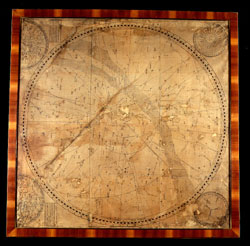 66. Celestial map by J. A. Schall von Bell
66. Celestial map by J. A. Schall von Bell
Since 1595 the Jesuit father Matteo Ricci - founder of the Catholic mission in China - had asked his superiors in Rome for an astronomer to help correct and update the Chinese calendar, demonstrating in this way the superiority of the western (and hence Catholic) culture to the Chinese. The request was repeated in 1605 and 1608 but, Ricci was to die in 1610 without seeing it acted upon. His successor in China, Nicola Longobardo, however managed to solicit the Pope who in 1619 sent 22 missionaries to China, among them several mathematicians. Among these was Johann Adam Schall von Bell of Costanza - Roman student of the Collegio Germanico and auditor of the lessons given by Galileo in Rome at the Collegio Romano - who brought with him the first telescope to arrive in China.
After predicting the solar eclipse of 21 June 1629 much more accurately than the Chinese and Mohammedan astronomers of the court had, Von Bell was appointed by the Emperor to see to the correction of the calendar, a work he undertook with the Milanese Giacomo Rho and with the epistolary assistance of Kepler: the help of Galileo, repeatedly requested, was refused.
Von Bell produced a great deal of scientific work in China in this period, including this large eight-panneled cartographic work whose general title is Two general maps of the stars to the north and south of the equator. Two exemplars can be found at the Vatican Library, one of which (mss. Barberini Orient. 149) was made for mounting on a screen for the Private Council of the Emperor and is in magnificent and bright colors, with gilded stars.
The Museo della Specola has only four panels. Three of these illustrate the northern hemisphere, with the north Pole at the centre, the Milky Way and stars visible to the naked eye.
The observations for the making of the map were done in Peking with the help of Chinese astronomers and the telescope, proof of the modernity of Von Bell’s work. The star coordinates are from the year 1628. One inscription shows the symbols of the six magnitudes of the stars and nebulae.
The fourth segment - wrongly inserted a few decades ago in the geographical map of Matteo Ricci [file 65] - includes the presentation of the work, written by the Chinese Paolo Siûcoamcchi (Hsû Kuang-ch’i), collaborator of von Bell. Illustrated, from the top down, are the maps of the oppositions and conjunctions of Jupiter, Mars and Venus, separated by two observational instruments - a theodolite and an azimuthal instrument - whose use is illustrated at the side, in the inscription. The maps were executed by a high official at the "Office of Astronomy", collaborator of von Bell, Wu Ming-chu.
Nothing is known about the origin of these relics. One hypothesis is that it reached Bologna via the Jesuit Giovan Battista Riccioli (1598-1671), professor of humanities, philosophy, theology and astronomy, first at Parma, then Bologna: his works do in fact speak of Matteo Ricci and Chinese astronomy.
For a detailed description and bibliography of the map see the work of father Pasquale D’Elia, published in Coelum in 1958; for a biography of Schall von Bell see Väth (1933) and the 1992 International Symposium to him dedicated.
P. D’Elia (1958), p. 41.
International Symposium on ... Johann Adam Schall von Bell (1992).
A. Väth (1933).